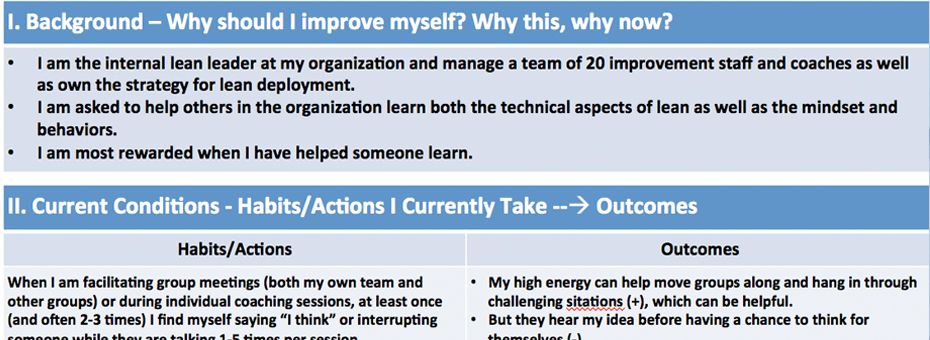I was first exposed to the personal A3 process by Margie Hagene, who at the time was my coach while I was the director of the Lean Promotion Office at a large healthcare system. Prior to then, I saw A3 thinking as a valuable process for solving organizations problems and gaining clarity for strategic direction.
Margie helped me recognize that the rigors of A3 problem solving could also be a framework for personal development. Using the A3 process focused on personal actions and behaviors could help individuals to identify, practice and strengthen their own habits, along with the support of a coach.
My personal improvement using A3 thinking
As an internal coach at the time, I found my actions were inconsistently aligned with what I knew were important behaviors that would develop problem solving capability in others, such as asking questions and modeling reflection (the Check-Adjust part of the PDCA cycle).
Sometimes I felt really effective as a coach and leader, but at other times I knew I was acting in ways that took away the thinking responsibility from others.
I realized that in circumstances where I felt under time constraints to “get the work done,” or where I was running from meeting to meeting, that I was not as effective as I wanted to be as a leader and manager. The pressure “get it all done” heightened my natural extroverted tendencies to jump in and offer up ideas and my “solutions,” rather than slow the pace of work down to ask additional questions and allow people time to think and develop. (Does this sound familiar to you?).
Margie suggested using a personal improvement A3 as a way take time for reflection and figure out how to change the actions that I found to be hindering the outcomes I wanted to achieve. We were actively using A3 thinking to solve organizational and strategic problems all around us; why not use this same thinking process to improve individually as well?
I decided to experiment with the personal A3 framework. By working through the A3 process and writing my current actions down on paper, I gained deeper awareness of strengths and limitations, and the reasons behind my actions. I also asked my direct reports to do the same, which allowed me to coach and support them in their ongoing improvement.
The title of my first (and several subsequent versions) personal improvement A3 was “Keeping the thinking with the problem owner” with a focus on getting out of my habit of telling and instead leading by asking questions and providing space for others to think and respond. [See A3.]

Even though I knew that my role as a lean coach and leader was to develop problem solving capabilities in other people, and that to do so I needed to give them the opportunity to think, I observed that my habit, more often than not, was to jump in with my opinion. I might start by asking a question or two, but soon would get caught up in solving the problem in by saying “I think…” and offering an idea or suggestion.
I started to collect data on myself by noting the frequency of my use of the phrase “I think…” or how often I interrupted someone make a statement. I usually did both at least once per interaction – and often more frequently. With my coach, I developed a focused plan of how to get “a little bit better” each day. Instead of just setting a macro-level goal such as “I want to be a better question asker,” I targeted a reduction into the amount of times I heard myself say “I think” or found myself interrupting to share my thinking over a three-month period.
I started this approach in individual coaching sessions. This included setting my intention immediately before each coaching interaction (remember: Don’t interrupt! Ask questions instead of saying “I think!”) and anticipating countermeasures of what to do if my stronger habits emerged (count to 10 after asking a question or when I feel the urge to interrupt, self-correct when I find myself saying “I think” and instead ask a question). This helped me stay focused and deliberate about my practice – and gave me a plan for when things when off course (which of course they did often).
By setting time for daily reflection on my practice and seeking out the support and feedback of others (including the people I was coaching), I saw dramatic reduction in the amount of times I used the phrase “I think” or interrupted someone.
Of course I failed a lot, but I learned from each instance more deeply about the triggers for my old habits. Over time, I gained greater awareness of my actions and it became easier and more natural. My new habits were getting stronger than my old ones.
Build upon improvement through multiple A3 iterations and practice
Over a period of many months, I continued my deliberate practice to strengthen these habits. During this time, I also transitioned to being an external independent coach and consultant.
When working with my clients, I became increasingly aware about how often I – and other consultants – would jump in with our opinion during group working sessions. In this group problem solving environment, it was easy for us to fall into the role of problem solvers rather than coaches. Of course there were times when our opinions or guidance was appropriate to best support our clients, but if we first led with our ideas, we didn’t give a chance for them to think and develop their own perspective.
I revisited my earlier A3 and reflected on what was triggering my actions in a group environment. I then developed countermeasures to strengthen my habit to ask more questions in group environments before offering my opinion.
We never fully extinguish old habits – we just replace them with stronger ones.
Through applying A3 thinking on myself and creating a plan of what and how to practice, I continue to get better (most) days. Over the past four years, it has become easier and more “natural” to lead with questions and not reflexively give my opinion. However, my instinct to jump in with my opinion has never been fully extinguished. I have to stay focused each and every day, no matter the environment, to not let my old habits come out.
Even this week, a physician leader whom I am coaching caught me self-correcting when I was about to give my opinion. When he asked me “what do you think I should do?,” my first instinct was to answer his question directly with my ideas.
I inhaled to start answering with “I think…”, but then paused, took a breath, and instead asked him a question so as to hear what had been exploring. He ended up answering his own question, and I shared only one additional points that he might consider for next steps. Afterward he reflected that this interaction had heightened his own awareness of his personal habit to rush in and how he might practice at getting better.
Coaching others for improvement using A3 Thinking
I have found that merely asking someone to reflect and write down their observations of their habits and the resulting impacts, can be a powerful accelerator for improvement—something folks call a “keystone habit.” Just starting a personal improvement A3 can lead to greater self-reflection and introspection, and this into itself leads to improvement in behavior.
Additionally, as a coach, supporting someone through a personal A3 allows you the opportunity to model effective coaching skills through catchball. The learner owns their action plan for improvement; and you have a specific focus for how you can support your learner develop.
What problem are you going to focus for your personal improvement?
How can you use this process to support the people you are developing to own their improvement and create an action plan that you can help support?
Managing to Learn
An Introduction to A3 Leadership and Problem-Solving.






